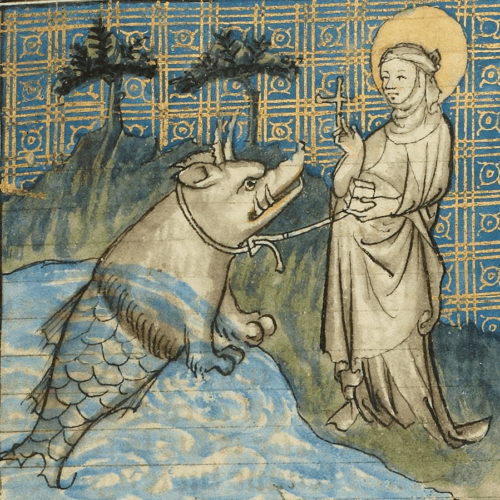How the Joy of Cooking led to St. Martha and the Dragon
You never really knew where and hoe a research rabbit hole is going to open up, even one with a dragon in it.
In this case, it started with the amazing book cover. Yes, it is real, and yes the image is a link to is, and no, I don’t have it … yet. The book description includes this amazing little tidbit: The book is illustrated with the silhouette cutouts created by Irma’s daughter Marion, who eventually wrote later editions of The Joy of Cooking. Marion also created the cover art depicting St. Martha of Bethany, the patron saint of cooking, slaying the dragon of kitchen drudgery.
So naturally I had to go chasing down to find out more about St. Martha and the Dragon! So here’s the rest of the story.
St. Martha and the Dragon
According to the 13th century “Golden Legend,” (a collection of 153 hagiographies by Jacobus de Voragine widely read in Europe during the Late Middle Ages), Martha, Mary, and Lazarus left (or were exiled from) Judea around 48 A.D. They were put into a ship without sail, oars, or rudder, which came to Marseilles. Afterward they wandered and came to the territory of Aix, in Provence. Martha preached to the people, and had a reputation of being courteous and gracious to them.
Martha went to Tarascon on the Rhone River, where a terrible dragon, the Tarasque, hid in the woods and in the river, devouring those that passed by and sinking ships on the river. Some descriptions depict the dragon to be half-animal and half-fish It was bigger than an ox, longer than a horse, with sharp teeth and scales like a pair of shields on either side of its body. Other nattatives portray the dragon having a lion-like head spewing poisonous breath, a body protected by turtle shell, six bear-clawed feet, and a serpent’s tail.
The villages told Martha that they would believe in the power of which she preached if it could rid them of the dragon. Being a woman of faith and rather more than average backbone, Martha found the dragon in the act of swallowing a (human) victim, subdued it with the sign of the cross and holy water, then brought it back to the village on a leash! The villagers took over from there.
A Possible Real-Life Dragon
Some believe that there is a distinct possibility that St. Martha or another figure from antiquity discovered a stray crocodile in that river. The description of a beast living both in the water and on land describes a crocodile quite well. Could an escaped crocodile on its way to a Roman amphitheater have found refuge in the marshland around the Rhone river? Stanger things have happened.
I prefer to think this was an early tale of the Blue Order in which an early dragon Keep and Keeper came to be.
Today St. Martha is recognized as the patron saint of cooks–hence her appearance on the cover of The Joy of Cooking. Her feast day is today, July 29!
Images of St. Martha and the Dragon

Jacques de Voragine, Legenda aurea (trad. Jean de Vignay). Manuscrit de BnF, fonds français 242, fol. 154.[3] Creative Commons Attribution-Share Alike 4.0 International


References
https://anunslife.org/blog/nun-talk/of-cooks-pirates-and-dragons-saint-martha
https://aleteia.org/2019/07/29/did-you-know-st-martha-became-a-dragon-slayer
https://www.wordonfire.org/articles/spirituality-st-martha-the-dragonslayer
http://emilymdeardo.com/blog/2015/7/19/st-martha-and-the-dragons?


You never know where a rabbit hole will lead you. How cool was that? Thanks for sharing. I hope all is well and drying out in your neck of the woods. Blessings.
This is my favorite kind of rabbit hole. Many thanks!